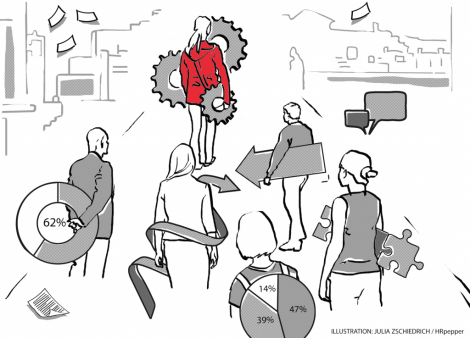PowerPoint makes communication (im)possible

From: Greta Müller
Nowadays, one can hardly imagine a meeting, a conference or any talk that is not based on a PowerPoint presentation. Hence, a major part of our communication is, by now, realized by making use of PowerPoint. But does that really have the intended effect of being more effective and efficient? Can and should decisions be made based on PowerPoint presentations? Various studies were conducted to get insights into the effect that PowerPoint has on the way we communicate in business settings.
Since the introduction of PowerPoint during the 1990s people make use of the many features that it has to offer: framing information in bullet points and slogans, using animations to stress the most important aspects and allowing the audience a fast apprehension of the given information. Just as long, critics discuss its drawbacks: Putting complex information into short and often insufficient bullet points as well as using appealing visual aids to support weak analysis. Graphics also often force linearity of argumentation and thereby limit improvisation, digression and inventiveness (Gabriel, 2008).
Edward Tufte, a US-American information scientist, is known for examining PowerPoint’s critical aspects. In 2003 he kicked off a debate concerning the question whether the software evaluated format over content. He illustrates this question by drawing on NASA’s fatal Columbia disaster in 2003. NASA technicians used PowerPoint for documentation purposes of their work – the crucial fault that caused the accident was mentioned only on the fourth sublevel of a bullet point list which apparently led to the fault getting underestimated by NASA’s management (Presidential Commission On Space Shuttle Challenger & Rogers, 1986). The consequences were fatal. One of the learnings: Parcelling of complex knowledge into bullet points can become problematic when using PowerPoint for purposes other than its primary function, i.e. facilitating face-to-face presentations. What does this mean for business context? PowerPoint presentations are often the main deliverable of project work and, as a result, get presented in result presentations. This draws up the following question: How valuable can one call a management decision that is made on appealing, but insufficient bullet points read without any in-depth explanations? (Kaplan, 2011; Presidential Commission On Space Shuttle Challenger & Rogers, 1986)
PowerPoint is also seen as having a great importance within the consulting sector where the creation and presentation of PowerPoint slides are part of a consultant’s day-to-day work. In one of his studies, the economist Schoeneborn examines the use of PowerPoint at an international business consulting firm through an empirical analysis of project documentation practices as well as interviews. He found out that PowerPoint presentations are mainly used to support face-to-face communication with clients and for purposes of internal communication, e.g. for project documentation. These project documentations only very rarely served their purpose – cross-project learning and information exchange between consultants. Schoeneborn proved that a highly abstracted summary with brief wording – typical characteristics of PowerPoint used for live presentations – makes it almost impossible to understand a project’s context. In provocative words: He showed that the practices of using PowerPoint as a presentation tool are altered through its adaptation to the tasks of organizational communication – and not vice versa (Schoeneborn, 2013).
But it would be way too easy to simply blame the software itself for the negative effects that it is criticized for. It is rather in every user’s control to use PowerPoint in a creative and contextual way. At this point, it is of great importance to distinguish between PowerPoint slides used as facilitators of face-to-face presentations or in their converted form as documents that get distributed digitally. If both forms get mixed up, their quality decreases. This is because the amount of information, then, is in most cases too high for a presentation and insufficient for a detailed documentation (Yates & Orlikowski, 2007). But if we aim at “comparing arguments with lists, enriching narratives with images and adding to the clarity of theories with graphs” (Gabriel, 2008), then PowerPoint can be considered as the unrivalled medium. In this case, the form of a presentation can create a “multimedia performance that elicits a critical, creative and active response from its audience”. Hence, using PowerPoint sophisticatedly means engaging with our society, in which multimedia experiences make up a great part of our daily routines (op. cit.).
Final take-home message: Even if it, indeed, sometimes seems like it – PowerPoint is not the only way out there. And even if it might be uncomfortable, we should more often question its usage.
Sources:

